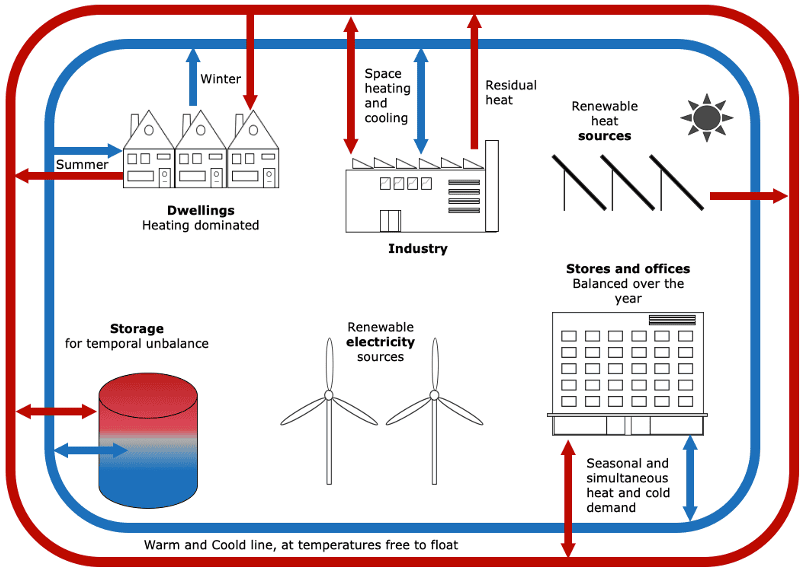What is 5GDHC?
Principles
Reuse as much residual heat and cold as possible. This principle is best applied bottom-up, with energy exchanges taking place first within a building/complex, then at cluster/neighbourhood level, and finally at city/district level. Because supply and demand of heat and cold do not match at the same time, cold or heat is temporarily stored in buffers. The cycle closes best if there is diversity in the type of users, with different profiles of supply and demand for heating or cooling. An optimal situation is for example if homes and offices are heated with the residual heat from a data center or supermarket.
The heating and cooling of buildings is a low-grade energy demand and must therefore be met as much as possible with low-grade sources. For heating a modern home, 35 degrees is enough and for cooling you need 15 degrees. For tap water, 65 degrees is required. This need can be met with low-value sources such as shallow geothermal energy, industrial residual heat, aquathermal energy (heat from surface water or sewage) or residual heat from cooling processes or data centres.
Energy production and transport only takes place where and when there is demand. It is important that energy production is decentralised, in order to minimise transport losses and to be able to respond flexibly to demand. This also makes it possible to provide heating and cooling at different temperatures in different places, without the entire system having to operate at those temperatures. So, a house has a pipe with cold water for cooling, with lukewarm water for space heating and with hot water for tap water.
Maximize energy efficiency in terms of production, supply and use through an integrated multi-level approach to different energy flows. Think, for example, of electricity from solar panels, and storage of excess power in electric cars. Or exchanging cold water and hot water in the ground, with a thermal energy storage source. Or when it comes to grid congestion at peak times, think of purchasing electricity to charge heat buffers.
In the past the DHC-networks were often planned at a large scale (neighbourhoods with many end-users) and with large, centralized heat plants as distant energy sources. The business case of such large and log systems is not always integral, does not account for all stakeholders taking part to them and also does not account for the evolution of stakeholders in terms of needs and objectives, so some costs were and still are seen as societal costs for the end-users and others. This principle aims to assess the local character of the electric and thermal energy production/transport and usage. As such a 5GDHC network should prioritize local energy sources above more distant ones, to reduce transport losses and investments and to maximize the use of local, renewable energy sources
DEFINITION
A 5th generation heating and cooling network (5GDHC) is based on the exchange of low-quality, renewable energy between buildings with different needs. The network transports a low-temperature water flow to decentralized substations, which increase the temperature demand to the required level in a controlled manner. Thermal storage bridges the time gaps between supply and demand and prevents electricity demand during peak hours. The concept optimises the proportion of low-grade renewable and residual heat and cold sources.

Benefits of 5GDHC
60-70% Reduction of Primary Energy Usage
Significantly lower primary energy consumption than individual air-source heat pumps, due to the use of a heat network.
Cooling integrated
Cooling integrated
Due to climate change, cooling of buildings will become increasingly important. With a 5GDHC you are therefore well into the future.
75% Less Electricity Consumption during Peak Hours
Because the network makes smart use of buffers and thermal mass, the required heat and cold can be generated outside peak hours. During peak periods, electricity consumption is minimized. During off-peak hours, maximum power is consumed. As a result, 5GDHC has a positive effect on grid congestion, the electricity purchased is greener and, with good market interaction, also much cheaper.
Stable Energy Prices
Due to its independence from fluctuating external factors such as the price of gas, the cost to the end-user will be predictable and stable
80% Reduction in Distribution Losses
80% Reduction in Distribution Losses
Energy losses are minimal, because the network temperature is close to the ambient temperature.
Plug & Play
Because the system is modular, new areas can be connected to it and it can grow from small to large. This can happen, for example, when a neighborhood has finished insulating its homes.
